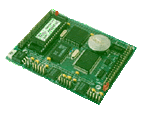module w/ 50+ I/Os, ADC, DAC, 3 UARTs

Specifications:
Measuring 3.6 by 2.3 by 0.3 inches, the A-Engine is a C/C++ programmable microprocessor core module (5V only) with a 16-bit 40/20 MHz CPU.
It supports up to 512 KB ROM/Flash, 512 KB battery-backed SRAM, and a 512-byte EEPROM.
A real-time clock (RTC72423) provides information on the year, month, date, hour, minute, second, and 1/64 second.
Two DMA-driven serial ports support communication up to 115,200 baud.
An optional (third) UART SCC2691 may be added.
The A-Engine can be integrated into an OEM product as a processor core component.
It also can be used to build a smart sensor, or a node in a distributed microprocessor system.
By building your product around the A-Engine, you reduce the time from design to market introduction, cut development costs, minimize technical risks, and deliver a more reliable product.
There are three 16-bit programmable timers/counters and a watchdog timer.
Two timers can be used to count or time external events up to 10 MHz.
They can also be used to generate non-repetitive or variable-duty-cycle waveforms as PWM outputs.
The Pulse Width Demodulation (PWD), a distinctive feature, can be used to measure the width of a signal in both its high and low phases.
This has potential in a variety of applications, such as bar-code reading.
The A-Engine has 32 user-programmable CPU I/O pins, plus 24 bi-directional, user-definable I/O pins from a PPI (82C55) chip.
Schmitt-trigger inverters are provided to increase noise immunity for external interrupt inputs.
A supervisor chip (691) provides power failure detection and a watchdog timer.
The 12-bit ADC has sample-and-hold, a high-impedance reference input, 11 single-ended 0-5V (or 0 to REF) inputs, and a 10 kHz sample rate.
Two 12-bit DAC provide 0 V to 4.095 V analog voltage outputs capable of sinking or sourcing 5 mA.
The 82C55 PPI can be used to interface to a 20x4 LCD and keypad or other controllers.
The A-Engine expects a regulated 5V voltage supply, and does not provide RS232 or RS485 drivers for the serial ports.
The VE232 can be used to provide this during development/debugging.
If you are using this controller stand-alone, you might want to consider the A-Engine-P.
The A-Engine-P is based on the A-Engine design, and offers an on-board 5-volt regulator and two RS-232 drivers, in addition to standard AE features.
The third optional UART SCC2691 can be either RS-232 (default) or RS-485, to be specified when ordering.
The A-Engine-P does not require the VE232.
The A-Engine shares a similar pin-out and physical dimensions with the 586-Engine, i386-Engine and V25-Engine-LM.
Be sure to also check out the A-Engine-86, which is a 16-bit external bus version of the A-Engine.
It has almost double the performance capabilities of the original A-Engine.
A-Engine-P Specs (adds)
Description: